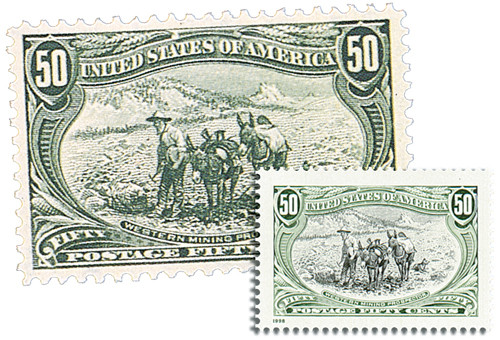
1998 50c Trans-Mississippi: Western Mining Prospector
# 3209g - 1998 50c Trans-Mississippi: Western Mining Prospector
$1.50 - $3.00
U.S. #3209g
1998 50¢ Western Mining Prospector
1998 50¢ Western Mining Prospector
First Day Cover
Issue Date: June 18, 1998
City: Anaheim, CA
City: Anaheim, CA
The stamp on this First Day Cover pictures a miner with his mules looking for gold. Like the 8¢ stamp, the image is based on a painting by Frederick Remington. The stamp is part of the Trans-Mississippi Exposition souvenir sheet issued to honor the 100th anniversary of the original commemoratives.
The Trans-Mississippi Exposition was held in Omaha, Nebraska, June 1 through November 1, 1898. Its goal was to further the progress and development of resources west of the Mississippi.
To publicize this event, a set of nine commemorative stamps was issued. Each was printed in a single color and featured an engraving depicting a different Western scene.
The original intent for the 1898 issues was to print them in two colors. However, due to the Spanish-American War and the increased demand for revenue stamps, resources were re-allocated and the stamps were printed in one color. The 1998 issues have been printed in two colors, using the only existing original bi-color dies.
U.S. #3209g
1998 50¢ Western Mining Prospector
1998 50¢ Western Mining Prospector
First Day Cover
Issue Date: June 18, 1998
City: Anaheim, CA
City: Anaheim, CA
The stamp on this First Day Cover pictures a miner with his mules looking for gold. Like the 8¢ stamp, the image is based on a painting by Frederick Remington. The stamp is part of the Trans-Mississippi Exposition souvenir sheet issued to honor the 100th anniversary of the original commemoratives.
The Trans-Mississippi Exposition was held in Omaha, Nebraska, June 1 through November 1, 1898. Its goal was to further the progress and development of resources west of the Mississippi.
To publicize this event, a set of nine commemorative stamps was issued. Each was printed in a single color and featured an engraving depicting a different Western scene.
The original intent for the 1898 issues was to print them in two colors. However, due to the Spanish-American War and the increased demand for revenue stamps, resources were re-allocated and the stamps were printed in one color. The 1998 issues have been printed in two colors, using the only existing original bi-color dies.














